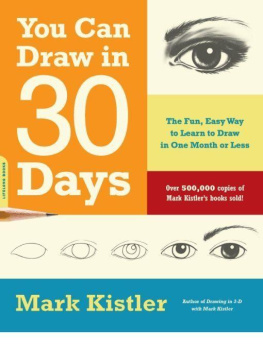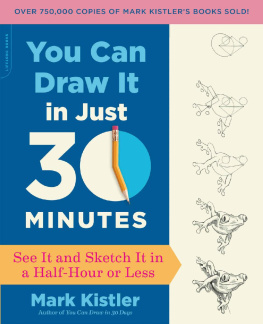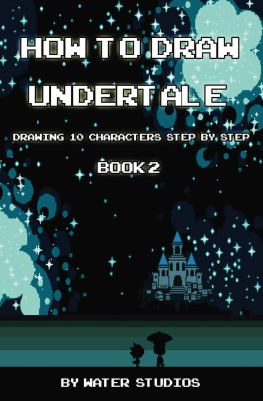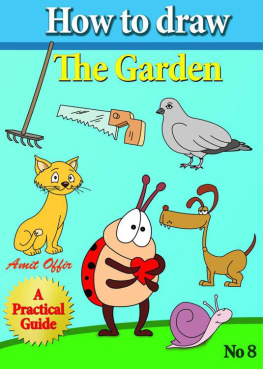Table of Contents
This book is dedicated to my dear sister Mari
(http://mari-kistler.memory-of.com/About.aspx)
Mari, LOOK! Youre in my book just like I promised you!
Introduction
Congratulations! If youve picked up this book, you are exploring the possibility that perhaps, just maybe, you really could learn to draw.
Guess what? Youre right! Even if you have little or no previous drawing experience, and even if you dont believe you have natural talent, if you can find a few pencils and twenty minutes a day for thirty days, you can learn to draw amazing pictures. Yes, you have found the right teacher. And yes, you have found the right book.
Welcome to my world of creative possibilities. You will learn to create realistic renderings of everything from photos to landscapes from the world you see around you and to draw three-dimensional pictures entirely from your imagination. I know this is a big claim filled with enormous promise. Im aware that you may be skeptical and wondering how I can make such a statement. The simplest way for me to qualify my teaching confidence is to share with you my past student success stories.
Drawing as a Learned Skill
During the last thirty years, Ive taught millions of people how to draw during my extensive travels around the country and through my television shows, websites, and videos. Many children have grown up watching my drawing lessons on public television and have gone on to pursue careers in illustration, animation, fashion design, design engineering, and architecture. I have alumni stus who have helped design the International Space Station, NASAs Space Shuttle, and Mars Exploration Rovers and others who have worked on animation megafilm projects such as Shrek, Madagascar, Flushed Away, The Incredibles, Happy Feet, and A Bugs Life.

But heres a secretlearning is learning and drawing is drawing, no matter how old you are. My techniques work for adults just as well as they work for kidsI know this, because Ive taught thousands of adults as well. In this book, I will introduce sophisticated concepts and complex drawing theories in a simple, easy-to-follow way, but because Im a kid at heart, I will not cut back on any of the fun that I believe drawing must be.
I am a cartoon illustrator by trade, but these lessons will give you the basic skill set that will enable you to draw three-dimensionally in any style (realistic drawings, photograph studies, portraits) or medium (oil paints, watercolors, pastels).
I will teach you how to draw using the same step-by-step, follow-along method that has proven successful for all my students. I will focus almost exclusively on what I call the Nine Fundamental Laws of Drawing, beginning with basic shapes, shading, and positioning, all the way through more advanced perspective, copying from photos, and drawing from life. These basic concepts, discovered and refined during the Italian Renaissance, have enabled artists to create three-dimensional renderings for more than five hundred years. I will teach you these basics, one key term at a time, one step at a time, one line at a time. I believe that anyone can learn how to draw; it is a learnable skill like reading or writing.
The Nine Fundamental Laws of Drawing create the illusion of depth. They are as follows:
1. Foreshortening: Distort an object to create the illusion that one part of it is closer to your eye.
2. Placement: Place an object lower on the surface of a picture to make it appear closer to your eye.
3. Size: Draw an object larger to make it appear closer to your eye.
4. Overlapping: Draw an object in front of another object to create the visual illusion that it is closer to your eye.
5. Shading: Draw darkness on an object opposite the positioned light source to create the illusion of depth.
6. Shadow: Draw darkness on the ground next to the object, opposite the positioned light source, to create the illusion of depth.
7. Contour lines: Draw curving lines wrapping around the shape of a round object to give it volume and depth.
8. Horizon line: Draw a horizontal reference line to create the illusion that objects in the picture are varying distances from your eye.
9. Density: Create the illusion of distance by drawing objects lighter and with less detail.
It is impossible to draw a three-dimensional image without applying one or more of these fundamental laws. These nine tools are foundational elements, never changing, always applicable, and totally transferable.
In addition to the Nine Fundamental Laws of Drawing, there are three principles to keep in mind: attitude, bonus details, and constant practice. I like to call them the ABCs of Successful Drawing.
1. Attitude: Nourishing your I can do this positive attitude is a crucial part of learning any new skill.
2. Bonus details: Add your own unique ideas and observations to your drawing to make it truly your own expression.
3. Constant practice: Repeated daily application of any new learned skill is absolutely necessary for successful mastery of the skill.
Without exercising these three principles, you will not be able to grow as an artist. Each one is essential to your creative development.
In this book, well also focus on how the Nine Laws are applied to the four basic molecules, or building blocks, of three-dimensional drawing: the sphere, the cube, the cylinder, and the cone.
You Can Learn to Draw
With each lesson, I will be introducing new information, terms, and techniques, but I also will be repeating definitions and applications youve previously learned. In fact, Ill be repeating myself so often that you will undoubtedly start to think, This guy sure repeats himself a lot! But I have found that repetition, review, and practice produce successand they also keep you from having to jump out of your lesson to hunt for the original explanation.
The biggest criticism I have received in thirty years of teaching is, You are teaching students to copy exactly what you are drawing! Wheres the originality? Wheres the creativity in that? Ive heard this comment countless times and always from a critic who has never drawn a lesson from my books, classes, website, or public television series. My response to this is always the same: Have you ever tried to draw a lesson with me? No. Here, sit down with this pencil and this rose lesson, right here at this table, for twenty minutes. In twenty minutes, after you complete this lesson, Ill answer that question for you. Most critics walk away, but a few adventurous souls actually do sit down and draw this rose lesson. For these idea explorers, the possibility lightbulb could almost be seen shining over their heads as they leaned over the table, drawing the rose.














